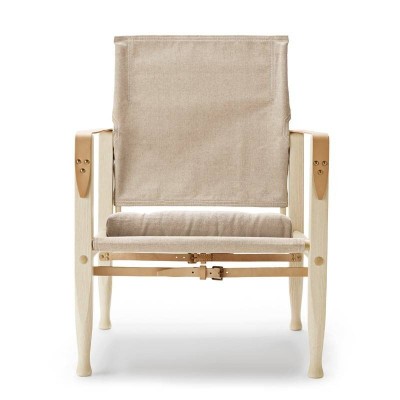













Armchair designed by Kaare Klint for Carl Hansen.
Combines natural ash wood structure with natural Canvas upholstery or canvas.
Kaare Klint, 1933.
Safari Chair - KK47000.
The Safari Chair is based on the Indian Roorkhee chairs used by the British military, arguably the earliest examples of self-assembled furniture, featuring glue-free joints, tool-free assembly, and clever construction that caused joints to tighten when the chair was occupied, improving strength and stability. Captivated by the chairs that an American cinematographer and his wife had used on their African safari, Kaare Klint set out to transform the portable detachable archetype into a sleek design for modern interiors.
Klint set about simplifying and refining the chair's composition, exhibiting his final design of the Safari chair in 1933. While inspired by its British predecessor, Klint's lightweight and sophisticated chair is defined by its signature systematic approach, fine craftsmanship, well-conceived proportions, and remarkable natural effects. The Safari armchair has an elegant design and is lightweight and very functional.
The chair's flexible construction means that it adapts to any surface where it is placed, such as the person sitting on it.
It is shipped disassembled in a small cardboard box, easy to assemble and disassemble without using any tools.
Material: solid ash wood, the seat and back are made of natural canvas (100% linen). The armrests and webbing are made of natural leather without any stitching. The legs are made of natural solid ash wood or smoked. Includes foam cushion with or without buttons.
Measurements: height 80 x seat height 34 x width 57 x depth 57 cm.
Data sheet
Specific References